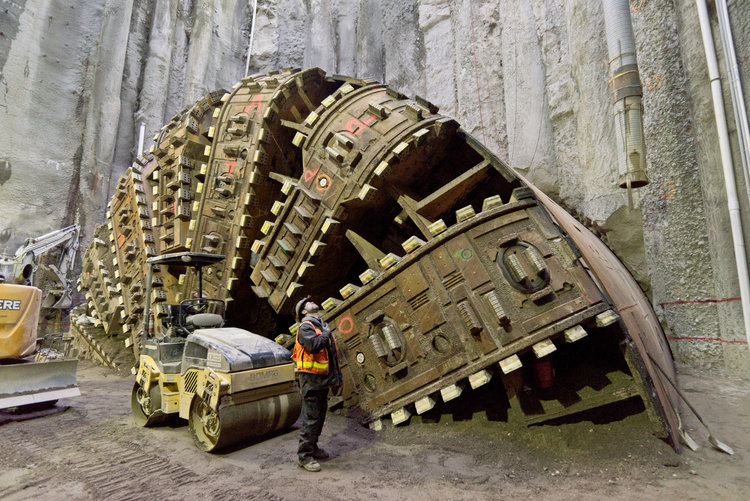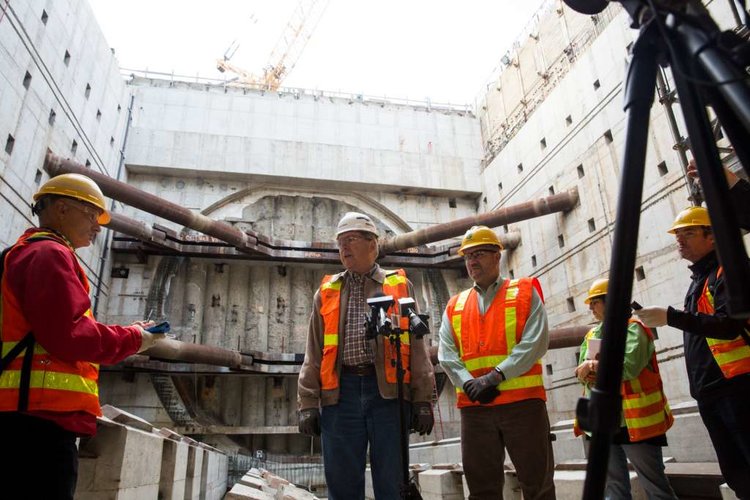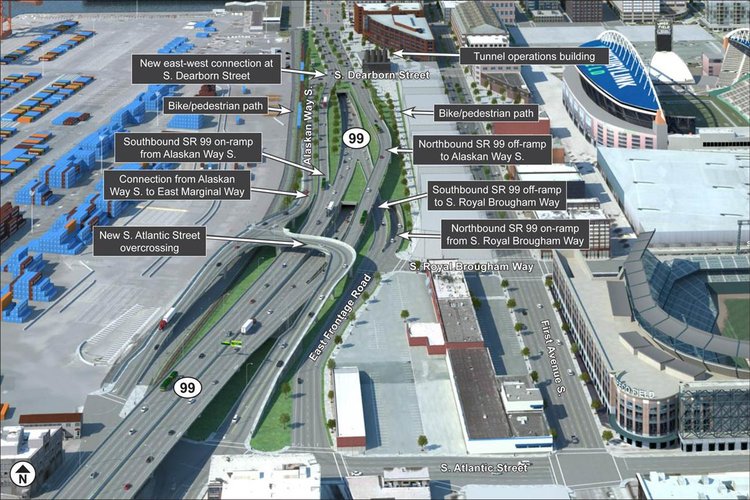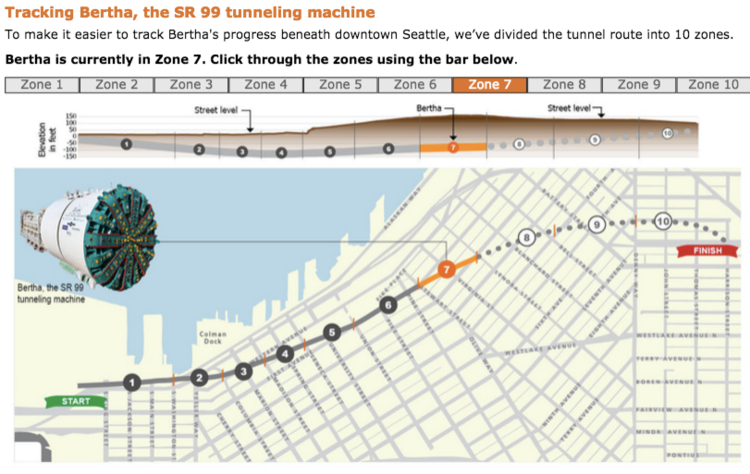
After standing idle for two years, the majority of that time 60 ft below grade, Bertha is back.
On Oct. 3, North America’s largest tunnel boring machine (TBM) — the beleaguered, 7,000-ton, 57-ft-dia behemoth affectionately dubbed “Bertha” — officially passed the half-way mark of a 9,270-ft-long tunnel dig across subterranean Seattle. Upon completion, the 57.5-ft-dia tunnel will accommodate a two-mile, double-deck highway section of State Route 99 (SR 99) that will replace the seismically compromised Alaskan Way Viaduct. Since the ceremony, the last seven weeks have only added to the $1.35-billion design-build project’s growing momentum and confidence. (The tunnel is just the most prominent of 31 related projects now under way, worth a combined $3.14 billion.)
“Everything’s going according to plan now,” said Chris Dixon, project manager for Seattle Tunnel Partners (STP), speaking to reporters last month. Added Joe Hedges, administrator with the Washington Dept. of Transportation’s (WSDOT) Alaskan Way Viaduct Replacement Project, “Today is a great day.”
“This is good progress,” added Washington Gov. Jay Inslee. “I appreciate everyone’s focus on making sure we safely complete this project.”
If the level of enthusiasm seems disproportionate for a mega-project that still has years to go, the emotions can be forgiven in light of the hurdles that had to be surmounted to get to this point.


Already, the achievement marks a stunning comeback for the massive, high-profile urban tunnel project, which seemed doomed after laser-guided Bertha had ground to a halt in December 2013. At that time, it had progressed 1,083 ft since starting TBM operations the previous June.
According to WSDOT, STP stopped Bertha after recording higher than normal internal temperatures. An initial investigation found no obstruction in front of the TBM. So, STP then cleaned the cutterhead and attempted to move Bertha forward. But again it overheated. After more investigation, STP found the seal system on the main bearing had been compromised. STP and Bertha manufacturer Hitachi Zosen later made the decision to repair the main bearing and investigate other damage from the surface.
What caused the damage is still in dispute and the subject of ongoing litigation.
STP has contended that the damage was caused by a 119-ft-long, 8-in-dia steel pipe that had been left in place after a previous state project. “WSDOT does not believe an 8-in steel well-casing caused the extensive damage to the tunneling machine,” said WSDOT spokeswoman Laura Newborn.
In the field, STP focused on the fix. An international joint venture of veteran tunneling contractors Tutor Perini and Spain’s Dragados USA, STP then began what The New York Times described as “what may well be the world’s biggest industrial operation.”
“When things break, it all scales up, and scales up the challenge as well,” said Youssef Hashhash, a professor of civil and environmental engineering at the University of Illinois, Urbana-Champaign. “When you have such a big machine, you (need) a big intervention,” he told reporters.
- Below, from October 2015, STP’s Chris Dixon describes the extensive TBM repairs.

In early 2014, the challenge then called for bringing Bertha, or portions of it, up to grade level to access the damaged components. But that expensive and lengthy operation rendered the project’s original completion date of 2015 virtually unachievable. At the time, the setback prompted The Seattle Star arts journal to suggest: “Here’s an idea: Cancel the tunnel!”
Stakeholders didn’t agree.
Although it is the smaller of two major corridors extending through Seattle, SR99 accommodates more than 100,000 vehicles per day. So, in spring 2014, crews began work on a concrete-lined vertical shaft to raise Bertha’s 2,000-ton front assembly, four pieces in all, to the surface for repairs via a rail-mounted crane. Devised by STP, the plan called on the expertise of Dutch lift specialist Mammomet, as well as TBM manufacturer Hitachi Zosen.
Upon completing the lift, Hitachi Zosen installed a re-designed seal system that, of note, is much more accessible “in the event we need to use it for maintenance and repair,” noted Dixon. Additional repairs and modifications performed between March and August 2015, including reconfiguring the cutting tools so the cutterhead performs more efficiently during the balance of the tunnel drive, Dixon said. Once repairs were complete, the front assembly was lowered into the ground in August 2015, leaving crews to reconnect wires, hose cables, and pipes by January 2016.

But problems continued to dog the project earlier this year, even after Bertha resumed operations. Crews encountered a 35-t-long, 15-ft-deep sinkhole behind the borer in January. “The sinkhole is an unfortunate event, but isn’t something that is unique or something that wasn’t anticipated,” Dixon explained.
Although the hole was quickly filled with 250 cu yds of concrete the next day, WA Gov. Inslee, responding to public pressure, ordered STP to halt work yet again and investigate the cause of the sinkhole and to implement modifications in soil monitoring to prevent future such occurrences. Work resumed in late February after plans were approved by an independent panel of experts. All told, interruptions and repairs added $223 million to project costs, WSDOT estimates.
Following the January mishap, “STP absolutely has demonstrated it can control the ground in terms of movement,” added WDOT’s Newborn.
cutting its teeth, eyeing 2017
Between April and October, Bertha cut and chewed through 3,000 feet of soil and rock. “Just on a straight line interpolation, we’re looking at seven (more) months of tunneling, if the next seven months go as fast as the last five months,” Dixon told reporters in October.
That puts the hole-through date some time in May of 2017.
For the remaining 50%, there’s a lot of unknowns, a lot of uncertainties, Hedges added during the interview. “And what we need to do is basically be consistent with our approach (to) get there safely.”
As Bertha wends its way under downtown Seattle, WSDOT is implementing a comprehensive program to monitor ground movement along its route, having consulted with geotechnical experts Soldata Inc. in surveying no fewer 4,000 points involving buildings, ground and utilities. As designed, large mounted survey machines on rooftops rotate and take readings of small monitoring points to measure movement on nearby buildings and ground, according to a statement by WSDOT. Information is transmitted to a computer system and continually recorded and reviewed by project team members for sinking or destabilization. The monitoring system also incorporates 700 below-grade ground monitors to monitor Bertha’s progress as it traverses under the 30 buildings in its path.
“If any ground movement even begins to show itself, the contractor can respond immediately,” WSDOT deputy program administrator David Sowers told reporters.
Meantime, Bertha is taking periodic breaks of up to a month for planned maintenance to ensure operations proceed smoothly. “This is typical of mining operations,” Newborn said. In September, for instance, STP replaced 10 of 12 cutting tools, which wear down after extended periods of operation.

Tunneling actually involves two operations in one: the tunnel dig and highway work bringing up the rear, according to Newborn. During the first operation, excavated dirt is transported through Bertha via a spiral screw conveyor, with an ever-growing conveyor belt dispatching the dirt out of the tunnel to barges. Meantime, crews in the rear are assembling 10 concrete segments dispatched by Bertha to create 2-ft-thick rings that function as the tunnel’s outer walls, Newborn said. In all, the machine will push off 1,450 rings, halting every 6 1/2 feet as a new ring is put in place.
As Bertha proceeds, crews behind it are working 24/7 to put the four-lane highway’s primary components — foundation, walls and top deck — in place,” Newborn noted, elaborating work on the bottom deck will not begin until Bertha has completed its work.
“We are building a standing sandwich, beginning with installation of 13 tons of steel for each 54-ft-long wall panel ”
“Because the tunnel is circular, we needed [square off with] a foundation a point from which to place the walls and deck,” Sowers explained in a video presentation. In this instance, the foundation consists a pair of concrete corbels, one for each side of the highway deck and reinforced with rebar to help contend with expansion and contraction of the concrete. Following construction of formwork, crews pour concrete for 54-ft-sections, let it set for a few days, then place moisture and plastic blankets over the concrete, allowing 28 days to cure and gain its required strength as it does so, Sowers explained.
Crews following behind are erecting highway walls to rest upon each corbel, a process Sowers described as building a “standing sandwich, beginning with installation of 13 tons of steel for each 54-ft.-long wall panel.” With steel in place, forms are erected on both sides, followed by the concrete pour. Once again, the concrete sets for a few days before crews cover it with moisture and plastic, allowing 28 days until the installation achieves its full design strength.
Next comes placing the upper road deck atop the two new walls. “There’s plenty of room under the deck to access the tunnel boring machine and continue mining operations,” Sowers noted. Reinforcing steel placed on top of formwork features an epoxy coating to reduce susceptibility to corrosion. Once again, with rebar in place, the pours begin. To finish off the upper portion, crews eventually will erect walls on either side of the road deck. Near the end of the project, “we’ll come in and erect a deck nestled directly on the corbels,” Sowers said. “In the interest of time and efficiency, this is the one part of the entire operation that is precast.”
By mid-October, about 41% of corbels, 34% of walls and 23% or roadways were complete, said Newborn, who added that work began on the highway while Bertha was awaiting repairs. Crews also constructed ramps and roadway connections at the tunnel’s north and south portals.
Digging for daylight, unearthing hindsight
STP schedules indicate tunneling will conclude in spring 2017 and then the project will be turned over to WSDOT in November 2018. Following the handover, WSDOT will complete road connections with an anticipated road opening of January 2019.
That’s three years later than originally planned, of course. While any project of this complexity and magnitude likely would have confronted challenges, it remains unclear how many of those hurdles could have been averted in this instance. For instance, some accounts have indicated that WSDOT may have known beforehand of the piping that broke Bertha, but thought incorrectly that it had been removed.
STP had made that assumption, as well, according to Dixon’s 2014 interview with The New York Times. “Under standard practice, when a well is installed and used and then its use is complete, it’s typically decommissioned by removing it from the ground — it’s a Department of Ecology requirement. We didn’t know the pipe was there,” he said. “The extent of damage caused by the mishap opens a Pandora’s Box of issues, with STP contending the pipe led to problems with the seal and WSDOT countering that one had nothing to do with the other. As a result, the design of Bertha has come into question, wit the state indicating it’s unlikely an 8-in.-diameter pipe could have caused such extensive damage. Insurance companies that balked at paying $143 million in repairs to Bertha blame the machine itself. Hitachi has experienced problems with the seals during commissioning in Japan,the insurers argued in a lawsuit.
It’s one of several several claims either filed, or waiting in the wings, pending completion of the project. Whether they point to sounder execution of projects of this complexity, whether by practice or technology, remains to be seen.
For now, as state Transportation Secretary Roger Millar recently stated, “Everyone on the team is working toward the day when the machine comes out the other side.”

Discussion
Be the first to leave a comment.
You must be a member of the BuiltWorlds community to join the discussion.